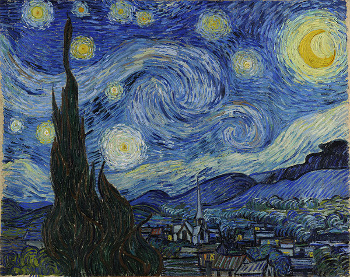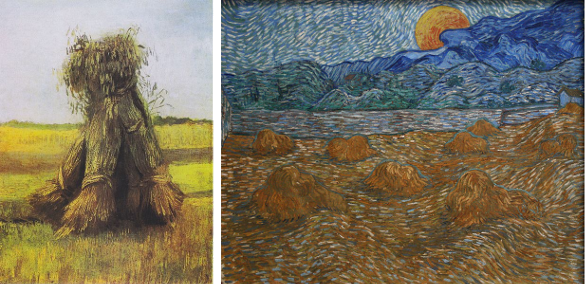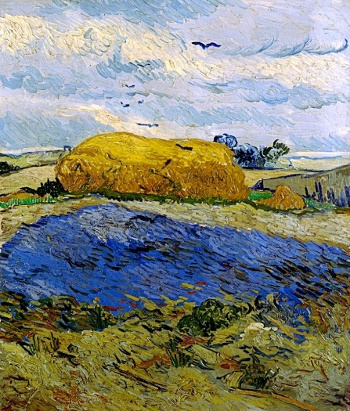Van Gogh's Fading Reds
April 9, 2015
Children are subject to many small disappointments throughout their
childhood. In my
youth, we lived in an older
house, since
demolished, that had interior
door locks opened by huge
keys. I was
gifted with one of those keys at about age six, and I was heartbroken when it was lost.
One smaller disappointment was finding my small,
red,
plastic airplane bleached to
pink after exposure to the
Sun's rays after
wintering on a
porch. Later, I learned about the mechanism of
photochemical bleaching of
organic dyes.

Red plastic airplane.
Photochemical bleaching is the reason why museums don't allow flash photography.
(Photo by Gwafton, via Wikimedia Commons.)
Some
inorganic materials change
color in response to
light, also. An
F-center, named after the combination of the
German words, Farbe (color) and Zentrum (center), is an
anionic vacancy in a
crystal. Such vacancies include missing
oxygen atoms in
oxides, and missing
chlorine or
fluorine atoms in
halides. Light absorbed by
electrons at these vacancies modify the
absorption spectrum of
visible light, such that
transparent materials, which appear to be
white in
polycrystalline form, become colored.
F-centers will change white
potassium chloride (KCl)
powder to a pleasant
violet color, while table salt (
sodium chloride, NaCl) will turn a
brownish-
yellow. Since F-centers are a type of
doping, it's possible to make F-center
lasers, usually from
single crystals of the halides. Excitation with intense
electromagnetic radiation, such as
X-rays and
gamma rays, will produce F-centers.
Although F-centers are one way for inorganic materials to change color, a color change is usually effected by
chemical modification. One simple example of how
environmental exposure can cause a color change is the response of
cobalt (II) chloride (CoCl
2) and
copper (II) chloride (CuCl
2) to
humidity. While
anhydrous CoCl
2 is
sky blue, its
hexahydrate form, CoCl
2·6H
2), is a deep
purple. Anhydrous CuCl
2 is brown, its dihydrate form, CuCl
2·2H
2), is
azure. These color changes have been used for decades as
humidity indicators.
The primary photochemical process of concern in the preservation of
oil paintings is the darkening of the protective
varnish on the surface. In some cases, however, more damaging photochemical processes take place in the pigment, itself. In a
previous article (Van Gogh Versus the Sulfates, March 1, 2011), I wrote about the photochemical color change of the yellow pigment of later works by the
Dutch artist,
Vincent van Gogh.
While in
France, van Gogh learned about a new yellow pigment from his artist friends. This new yellow pigment was lead chromate, PbCrO4, which at the time seemed like a better yellow than that in common use; namely, yellow ochre, which is the hydrated form of iron oxide, Fe2O3·H2O.

Vincent van Gogh (1853-1890), "The Starry Night" (1889, Oil on canvas).
(Museum of Modern Art, Accession number 472.1941, via Wikimedia Commons.)
Eventually, this "chrome yellow" was found to turn brown when exposed to light. The culprit in this color change was found to be trace quantities of
sulfates that
reduced Cr6+ to Cr3+.[1-2] The valence change shifts the pigment color to green, causing the darkening effect.
Another pigment used by van Gogh and many artists of his period was
red lead, Pb
3O
4, also called minium. This pigment, known from antiquity, will whiten upon extended exposure to light through the formation of
anglesite (PbSO
4), or
lead carbonate, PbCO
3, also known by its mineral name,
cerussite. This pigment will darken, also, under other circumstances through conversion to the beta-phase of lead oxide, β-PbO
2,
plattnerite, or lead (II) sulfide, PbS,
galena.[3]
While Picasso had his "
blue period," van Gogh had his "
wheat series" that ran from 1885 until his death in 1890. His first such painting, Wheat Sheaves, was done with rather drab colors, while the later ones, painted in
France, were more colorful (see figure).

Left, Wheat sheaves in a field, August, 1885; right, Landscape with wheat sheaves and rising moon, July, 1889; both from the Kröller-Müller Museum, via Wikimedia Commons)
A team of
scientists from the
University of Antwerp (Antwerp, Belgium) has recently
published an analysis of the bleaching of the red pigment in van Gogh's, “Wheat Stack under a Cloudy Sky,” an
oil on canvas painted in 1889 and presently at the
Kröller-Müller Museum in the
Netherlands.[3-5] Says
Koen Janssens, research team leader and a
professor in its
Department of Chemistry,
"Normally, the idea is these paintings are there for a hundred years, or five hundred years, and they're static – nothing really changes... but the opposite is actually true when you look in detail."[5]
The
Antwerp team examined a minute white particle from the
pond area in the painting, and they used X-ray
powder diffraction mapping and
tomography to determine the chemical
phases present. The equipment, at the
DESY synchrotron light source,
PETRA III, allowed a depth profiling of the specimen.[4-5] What they discovered was an extremely rare lead mineral, plumbonacrite, 3PbCO
3·Pb(OH)
2·PbO), which is the first report of this chemical compound in a painting created prior to the mid-
20th century.[3]

Vincent van Gogh (1853-1890), Wheat stack under a cloudy sky (Korenschelf onder wolkenlucht), oil on canvas, October 1889.
(© Collection of the Kröller-Müller Museum, Otterlo, The Netherlands and used with permission.)
This observation enabled a
conjectured reaction pathway for such pigment bleaching in which both light and
carbon dioxide are required. Red lead is converted into plumbonacrite when exposed to light, and the plumbonacrite reacts with carbon dioxide to form lead carbonate, cerussite, and its hydrated form, hydrocerussite.[5] The light irradiation moves
electrons from the
valence band to the
conduction band in the
semiconducting red lead.[4] This reduces the Pb
3O
4 red lead to PbO, which reacts with the CO
2 from the environment to form plumbonacrite. The plumbonacrite is converted into the cerussite compounds by further absorption of CO
2, thereby whitening the red pigment.[4]
Of course, none of this work would have been possible without the sample from the Kröller-Müller Museum, and the authors acknowledge this in their paper. Also acknowledged are the
Helmholtz Association for the PETRA III light source at DESY, and the University of Antwerp.[3]
References:
- Letizia Monico, Geert Van der Snick, Koen Janssens, Wout De Nolf, Costanza Miliani, Johan Verbeeck, He Tian, Haiyan Tan, Joris Dik, Marie Radepont and Marine Cotte, "Degradation Process of Lead Chromate in Paintings by Vincent van Gogh Studied by Means of Synchrotron X-ray Spectromicroscopy and Related Methods. 1. Artificially Aged Model Samples," Anal. Chem., vol. 83, no. 4 (February 14, 2011), pp, 1214-1223.
- Letizia Monico, Geert Van der Snick, Koen Janssens, Wout De Nolf, Costanza Miliani, Joris Dik, Marie Radepont, Ella Hendriks, Muriel Geldof and Marine Cotte, "Degradation Process of Lead Chromate in Paintings by Vincent van Gogh Studied by Means of Synchrotron X-ray Spectromicroscopy and Related Methods. 2. Original Paint Layer Samples," Anal. Chem., vol. 83, no. 4 (February 14, 2011), pp, 1224-1231.
- Frederik Vanmeert, Geert Van der Snickt, and Koen Janssens, "Plumbonacrite Identified by X-ray Powder Diffraction Tomography as a Missing Link during Degradation of Red Lead in a Van Gogh Painting," Angew. Chem., vol. 127, no. 12 (March 16, 2015), pp. 3678-3681, doi: 10.1002/ange.201411691.
- Fading Orange-Red in Van Gogh's paintings, Deutsches Elektronen-Synchrotron Press Release, March 10, 2015.
- Matthew Gunther, "Shedding light on fading reds in Van Gogh's paintings," Chemistry World, March 3, 2015.
Permanent Link to this article
Linked Keywords: Child; Children; childhood; youth; house; demolition; demolish; door; lock; key; gift; red; plastic; airplane; bleached; pink; sunlight; Sun's rays; winter; wintering; porch; photochemistry; photochemical bleaching; organic compound; dye; museum; flash photography; Wikimedia Commons; inorganic compound; inorganic material; color; light; F-center; German language; anionic; vacancy defect; crystal; oxygen; atom; oxide; chlorine; fluorine; halide; electron; absorption spectrum; visible light; transparency; transparent; white; polycrystalline; potassium chloride; powder; violet color; sodium chloride; brownish-yellow; dopant; doping; laser; single crystal; electromagnetic radiation; X-ray; gamma ray; chemical reaction; chemical modification; environment; cobalt (II) chloride; copper (II) chloride; humidity; anhydrous; sky blue; hydrate; hexahydrate; purple; azure; humidity indicator; oil paintings; varnish; pigment; Dutch; artist; Vincent van Gogh (1853-1890); France; lead chromate; yellow ochre; iron oxide; The Starry Night; Museum of Modern Art; trace element; sulfate; redox; reduce; green; red lead; anglesite; lead carbonate; cerussite; plattnerite; galena; Picasso's Blue Period; Van Gogh wheat series; France; Weizengarben auf einem Feld; Wheat sheaves in a field, August, 1885; Landscape with wheat sheaves and rising moon, July, 1889; Kröller-Müller Museum; scientist; University of Antwerp (Antwerp, Belgium); scientific literature; publish; oil on canvas; Kröller-Müller Museum; Otterlo; Netherlands; Koen Janssens; professor; Department of Chemistry; Antwerp; pond; powder diffraction; tomography; phase; Deutsches Elektronen-Synchrotron; DESY; synchrotron light source; PETRA III; 20th century; conjecture; chemical reaction; carbon dioxide; electron; valence band; conduction band; semiconductor; semiconducting; Helmholtz Association of German Research Centres.